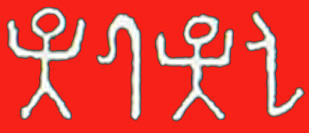
THE MICHIGAN ARTIFACTS

 |
THE MICHIGAN ARTIFACTS |
 |
|
|
||
|
The picture above is a Michigan tablet that depicts the TEN COMMANDMENTS.
The figure in the center seems to represent the Father in heaven.
The symbol
Notice for each commandment there are groups of dots at (like counting dots on dominoes) at the outer edge, these are numbering from 1 to 10, obviously indicating the TEN COMMANDMENTS. The letters contained in these Ten Commandments are similar to Egyptian style hieroglyphics.
The letters just left of the central figure are Cuneiform letters called the
Mystic Symbol and are seen on most of the drawings of the Michigan
tablets. These letters, James Adair noted amongst the Choctaw and Florida Indians a form of the sacred name which was Yo He Wah. Years ago attending a Feast of Tabernacles down in Kerrville Texas where we had a formal reading of the book of Deuteronomy, where persons would take turns reading from the Scriptures. When the readers came to capital LORD (which indicates in the King James Version where the tetragrammaton originally appeared in the Hebrew Scriptures), some readers would say Yahweh, while others would say Yahuwah, but when one sister came to it, she was uncertain of the exact pronunciation, so she would simply say the four letters "Yod He Vav He". Later on she began using "Yod He Waw He". To me it sounded much like what James Adair heard, possibly through time the three letters Yod He Waw turned into Yo He Wah. Similar to the three letters of the Michigan tablets. The Michigan tablets were found in 27 counties, and are obviously authentic as Daniel Soper put so well, "I have personal knowledge of more than 3,000 articles that have been found, and if they are and were buried to be found, whoever buried them has been a very busy person, because they have been found throughout the state by hundreds of different people." Humanity should have learned a lesson long ago, when the common people were waiting for their religious leaders to announce YAHUSHUA to be the Messiah. We shall make the same mistake if we are going to wait for the approved academia to pronounce all these artifacts and others genuine, or tell us what truth is. You have a mind! So you will have to use it and weigh the evidence yourself. |